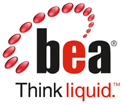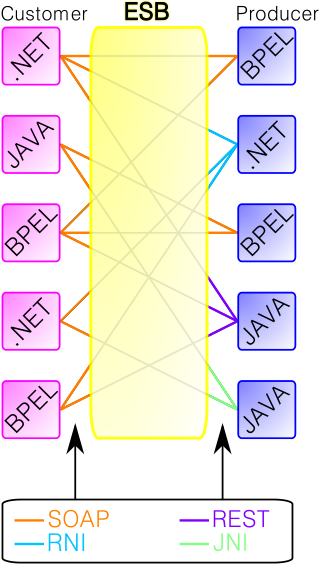Related Research Articles
A business process, business method or business function is a collection of related, structured activities or tasks performed by people or equipment in which a specific sequence produces a service or product for a particular customer or customers. Business processes occur at all organizational levels and may or may not be visible to the customers. A business process may often be visualized (modeled) as a flowchart of a sequence of activities with interleaving decision points or as a process matrix of a sequence of activities with relevance rules based on data in the process. The benefits of using business processes include improved customer satisfaction and improved agility for reacting to rapid market change. Process-oriented organizations break down the barriers of structural departments and try to avoid functional silos.

BEA Systems, Inc. was a company that specialized in enterprise infrastructure software products, which was wholly acquired by Oracle Corporation on April 29, 2008.
In software engineering, service-oriented architecture (SOA) is an architectural style that focuses on discrete services instead of a monolithic design. By consequence, it is also applied in the field of software design where services are provided to the other components by application components, through a communication protocol over a network. A service is a discrete unit of functionality that can be accessed remotely and acted upon and updated independently, such as retrieving a credit card statement online. SOA is also intended to be independent of vendors, products and technologies.

An enterprise service bus (ESB) implements a communication system between mutually interacting software applications in a service-oriented architecture (SOA). It represents a software architecture for distributed computing, and is a special variant of the more general client-server model, wherein any application may behave as server or client. ESB promotes agility and flexibility with regard to high-level protocol communication between applications. Its primary use is in enterprise application integration (EAI) of heterogeneous and complex service landscapes.

Business process modeling (BPM) in business process management and systems engineering is the activity of representing processes of an enterprise, so that the current business processes may be analyzed, improved, and automated. BPM is typically performed by business analysts, who provide expertise in the modeling discipline; by subject matter experts, who have specialized knowledge of the processes being modeled; or more commonly by a team comprising both. Alternatively, the process model can be derived directly from events' logs using process mining tools.
Enterprise architecture (EA) is a business function concerned with the structures and behaviours of a business, especially business roles and processes that create and use business data. The international definition according to the Federation of Enterprise Architecture Professional Organizations is "a well-defined practice for conducting enterprise analysis, design, planning, and implementation, using a comprehensive approach at all times, for the successful development and execution of strategy. Enterprise architecture applies architecture principles and practices to guide organizations through the business, information, process, and technology changes necessary to execute their strategies. These practices utilize the various aspects of an enterprise to identify, motivate, and achieve these changes."
A job scheduler is a computer application for controlling unattended background program execution of jobs. This is commonly called batch scheduling, as execution of non-interactive jobs is often called batch processing, though traditional job and batch are distinguished and contrasted; see that page for details. Other synonyms include batch system, distributed resource management system (DRMS), distributed resource manager (DRM), and, commonly today, workload automation (WLA). The data structure of jobs to run is known as the job queue.
A mashup, in web development, is a web page or web application that uses content from more than one source to create a single new service displayed in a single graphical interface. For example, a user could combine the addresses and photographs of their library branches with a Google map to create a map mashup. The term implies easy, fast integration, frequently using open application programming interfaces and data sources to produce enriched results that were not necessarily the original reason for producing the raw source data. The term mashup originally comes from creating something by combining elements from two or more sources.
Oracle Fusion Middleware consists of several software products from Oracle Corporation. FMW spans multiple services, including Java EE and developer tools, integration services, business intelligence, collaboration, and content management. FMW depends on open standards such as BPEL, SOAP, XML and JMS.
Service-orientation is a design paradigm for computer software in the form of services. The principles of service-oriented design stress the separation of concerns in the software. Applying service-orientation results in units of software partitioned into discrete, autonomous, and network-accessible units, each designed to solve an individual concern. These units qualify as services.
Network Agility is an architectural discipline for computer networking. It can be defined as:
The Oracle unified method (OUM), first released by Oracle Corporation in 2006, is a standards-based method with roots in the unified process (UP). OUM is business-process and use-case driven and includes support for the Unified Modeling Language (UML), though the use of UML is not required. OUM combines these standards with aspects of Oracle's legacy methods and Oracle implementation best-practices.
Service-oriented modeling is the discipline of modeling business and software systems, for the purpose of designing and specifying service-oriented business systems within a variety of architectural styles and paradigms, such as application architecture, service-oriented architecture, microservices, and cloud computing.
Agile Communication Environment (ACE) is a software product developed by Avaya. It uses a service-oriented architecture (SOA) and web services to integrate unified communications capabilities with business applications and processes.
Business process management (BPM) is the discipline in which people use various methods to discover, model, analyze, measure, improve, optimize, and automate business processes. Any combination of methods used to manage a company's business processes is BPM. Processes can be structured and repeatable or unstructured and variable. Though not required, enabling technologies are often used with BPM.
CMDBuild is an open source web enterprise environment to configure custom applications for asset management.
Service-orientation design principles are proposed principles for developing the solution logic of services within service-oriented architectures (SOA).
The JBoss Enterprise SOA Platform is free software/open-source Java EE-based service-oriented architecture (SOA) software. The JBoss Enterprise SOA Platform is part of the JBoss Enterprise Middleware portfolio of software. The JBoss Enterprise SOA Platform enables enterprises to integrate services, handle business events, and automate business processes, linking IT resources, data, services and applications. Because it is Java-based, the JBoss application server operates cross-platform: usable on any operating system that supports Java. The JBoss SOA Platform was developed by JBoss, now a division of Red Hat.
In software engineering, service virtualization or service virtualisation is a method to emulate the behavior of specific components in heterogeneous component-based applications such as API-driven applications, cloud-based applications and service-oriented architectures. It is used to provide software development and QA/testing teams access to dependent system components that are needed to exercise an application under test (AUT), but are unavailable or difficult-to-access for development and testing purposes. With the behavior of the dependent components "virtualized", testing and development can proceed without accessing the actual live components. Service virtualization is recognized by vendors, industry analysts, and industry publications as being different than mocking. See here for a Comparison of API simulation tools.
Unified interoperability is the property of a system that allows for the integration of real-time and non-real time communications, activities, data, and information services and the display and coordination of those services across systems and devices. Unified interoperability provides the capability to communicate and exchange processing across different applications, data, and infrastructure.
References
- 1 2 3 Gilbert, Phil. "A Business Oriented Architecture Combining BPM and SOA for Competitive Advantage". BPTrends. Retrieved 25 March 2013.
- 1 2 "New Innovation in Financial Services Competitiveness and Transparency". Financial Services. Retrieved 8 January 2024.[ permanent dead link ]
- ↑ Moe, John. "Business Oriented Architecture and SOA". ModernAnalyst.com. Retrieved 25 March 2013.
- 1 2 3 Moss, Simon. "Pneuron: A Business Orientated Architecture and ETL". Pneuron. Archived from the original on 11 April 2013. Retrieved 25 March 2013.
- 1 2 3 4 5 Moran, Andrew. "Industry making the transition to Business Oriented Architecture". Digital Journal. Retrieved 25 March 2013.
- 1 2 "Business Oriented Architecture". Sath. Archived from the original on 11 April 2013. Retrieved 25 March 2013.
- 1 2 3 4 Bandoim, Lana. "Business Oriented Architecture Becomes the New Focus". Technorati. Archived from the original on 11 April 2013. Retrieved 25 March 2013.
- 1 2 Speer, Pat. "Is BOA the New SOA?". Information Management. Retrieved 25 March 2013.
- 1 2 3 4 5 Mizen, Miranda. "Data Agility: Turning a Liability into an Asset". TABB Group. Archived from the original on 18 June 2012. Retrieved 25 March 2013.
- ↑ "TABB Forum: Will Technology Kill the Banking Business? (video)". SproutVideo.com. Retrieved 25 March 2013.[ permanent dead link ]